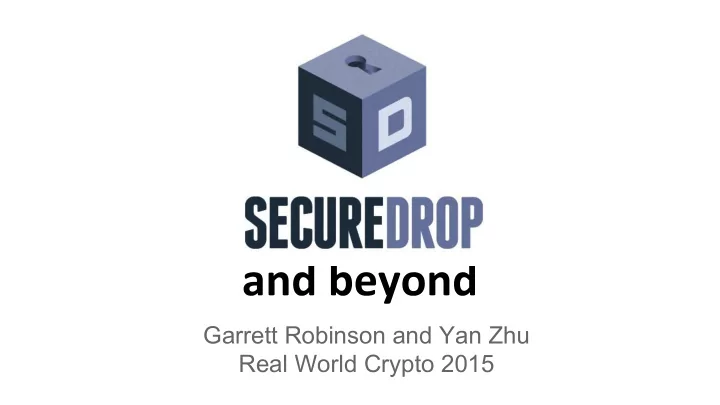

Garrett Robinson and Yan Zhu Real World Crypto 2015
Goal i dunno how to PGP [encrypted] [encrypted]
Who uses it? https://freedom.press/securedrop/directory
Threat Model Assets ● Source’s identity ● Confidentiality & integrity of submissions ● Confidentiality, authenticity, & integrity of messages between source and journalists
Threat Model Adversary ● Active network attacker ● Could seize server ● Could seize and search devices of suspected sources
Demo
Desired properties for SD 1.0 ● Forensic deniability for sources ● Resilience against SD server compromise ● Flexible client model ● Usability for everyone ● Leverage existing tools
challenges
1. End-to-end encryption
Why end-to-end? ● Reduce potential harm of server compromise ● Simplifies server implementation, reducing attack surface ● Defense in depth
Challenge ● Inherent conflict with forensic deniability ● Where do we store the key?
Solution #1 ● Generate key in the client ● Encrypt the key with a secret (e.g. passphrase) ● Store the encrypted key on the server ● Problem : adversary who gains copy of encrypted private key can try to guess the passphrase
Improvements ● Idea: require “strong” passphrases ○ Use entropy estimator such as Dropbox’s zxcvbn ○ h/t to Minilock ● Idea: auto-generate strong passphrase ○ e.g. Diceware passphrases ○ 8-word Diceware: 104 bits of entropy ● Idea: increase resistance to guessing ○ scrypt
Tradeoff ● Want to minimize cognitive load on sources ● We reuse a single token, the codename , as a username and a passphrase ● Makes salting tricky ○ Want to salt to prevent precomputation ○ Need salt to hash (scrypt) to create authenticator ○ Need authenticator to know which salt to use (in a typical random-salt-per-user system)
Proposal ● Use a unique per-instance salt, or a pepper ● All SecureDrop instances are independent and noninteroperable ● Server must be compromised to even start precomputing ● Effort must be repeated for each server
Setup flow 1. Generate keypair (sk, pk) on client 2. Fetch salt s from server 3. Stretch human-memorable passphrase (codename) with function S: S(p, s) → p' 4. Create authenticator a with any secure hash function H: H(p') = a 5. Encrypt private key pk with stretched passphrase p': E (p', pk) = c 6. Store on server: c, a, pk
Signing in 1. Authenticate a. Fetch salt s from server b. Derive authenticator: H(S(s, p)) = a c. Send a to server. If a matches, server returns c. 2. Decrypt private key on client a. D(S(s, p), c) = sk 3. Can now decrypt messages on client, sign submissions, etc.
Solution #2 ● Derive the key from the passphrase ● Inspired by Nadim Kobeissi’s minilock
Solution #2 human-memorable secret s scrypt( s ) sha256 twiddle bits curve25519_public
Pros/Cons ● Similar security properties ○ Both require adversary to compromise server ○ Very similar difficulty in guessing passphrase ● Solution #1 pro : can use any public key cryptosystem ● Solution #2 pro : neat!
2. Secure code delivery
Server code delivery $ gpg --keyserver pool.sks-keyservers.net --recv-key B89A29DB2128160B8E4B1B4CBADDE0C7FC9F6818 $ gpg --fingerprint B89A29DB2128160B8E4B1B4CBADDE0C7FC9F6818 $ git clone https://github.com/freedomofpress/securedrop.git $ git checkout 0.3 PROFIT!!1 $$$ Y $ git tag -v 0.3 N freak out :(
Client code delivery not as easy . . .
HTTPS:// (or Tor Hidden Service)
Option 1: regular Tor Hidden Service website (strawman) ● No software installation beyond TBB ● Good forensic deniability ● Poor sandboxing ● No code signing ● Hard to detect backdoors ● Grade: D
Why not make the web platform safe for crypto? ● Lots of recent progress here (Content Security Policy, WebCrypto API) ● Example: use Service Workers to “trust” code on first use ● Limitations: slow standardization process + TBB is ESR Firefox :(
Option 2a: TBB extension for secure messaging in general ● Good forensic deniability, especially if included in TBB by default ● Better sandboxing than a normal web page ● “prollyfill” for future web standards ● Can be compromised by another malicious installed extension ● Need to support many use cases ● Grade: A
Option 2b: TBB extension for SecureDrop only ● Only support one use case ● Better sandboxing than a normal web page ● Can be compromised by another malicious installed extension ● Low chance of getting into TBB by default; otherwise poor forensic deniability ● Grade: C
Option 3: Native desktop client ● Much smaller attack surface than a browser ● Poor forensic deniability (unless included in TAILS, etc.) ● Need to support multiple platforms ● Loneliness ● Grade: B
Package managers protect us from: ● MITMs ● Malware pretending to be legit . . . or not
Package managers should protect us from:
Package managers need code transparency Two guarantees against backdoors: 1. Package that Alice installs is the same as package that everyone else installs. 2. Code that Alice runs corresponds to the publicly available source code.
Solutions ● Put all package hashes into a public append-only log, which client checks before installing. (“Binary transparency”) ● Implement reproducible build process ● [Your ideas here]
Questions? ● https://freedom.press/securedrop ● Twitter: ○ @FreedomofPress ○ @bcrypt ○ @garrettr_ ● We’re hiring! https://freedom.press/jobs
Recommend
More recommend